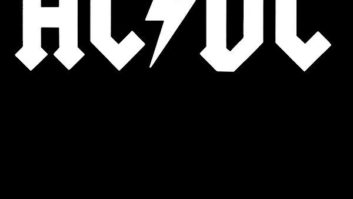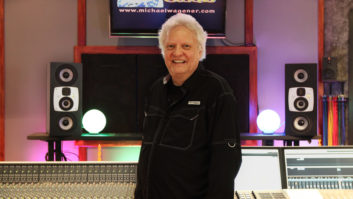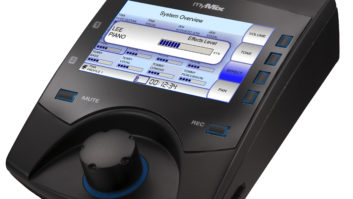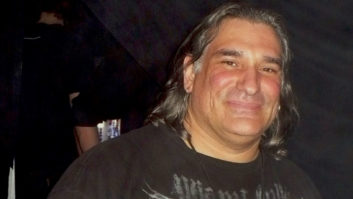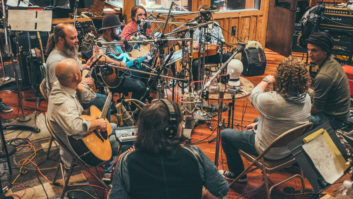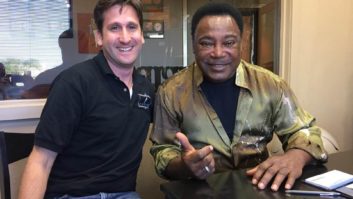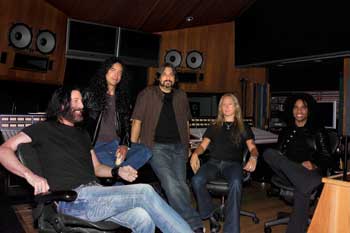
In Henson Studios, where the mixing and some tracking were done, are (L-R) drummer Sean Kinney, bassist Mike Inez, producer Nick Raskulinecz, guitarist/vocalist Jerry Cantrell, guitarist/vocalist William DuVall
Photo: Beatriz Thibeaux
In 1990, Seattle-based Alice in Chains were opening for Van Halen, Ozzy Osbourne and even Poison, playing a post-punk/metal hybrid that emphasized bitter truths and sludgy tempos, seemingly turning singer Layne Staley’s battle with heroin addiction into a theme. After Nirvana and Pearl Jam put Seattle on the alt-rock map, Alice in Chains got a song on the soundtrack to the 1992 Cameron Crowe film Singles, cementing the band’s grunge cred (to the sneering indifference of the members) and setting the stage for Dirt — released that same year — a rough beast slouching toward the top of the charts and eventual status as an art-metal landmark. By ’95, when the band released its self-titled third album, Staley’s addiction had caused them to stop touring, and the lack of a follow-up studio LP suggested that the singer’s demons were getting the best of him. Staley succumbed to a fatal overdose of heroin and cocaine in 2002.
When the word spread last year that the surviving members — guitarist/singer Jerry Cantrell, drummer Sean Kinney and bassist Mike Inez — were making an Alice in Chains record with another singer, the news was greeted with disbelief by the band’s obsessive fans, who believed the group had died with Staley. “I personally thrive on shit like that,” says Cantrell. “If you tell us we can’t do something, that just gives us more fuel to achieve it.”
The new album, Black Gives Way to Blue, the band’s first studio album in 14 years, is a dark, lush, engulfing and ultimately uplifting work that wrestles with absence as both a tribute and a challenge. It introduces vocalist and guitar player William DuVall, 42, who’s been playing off and on with Cantrell since 2000. “William is not Layne, and he’s not trying to be,” Cantrell asserts. “But there are some similarities, which work for the band. Even though the personnel is different, it’s evolved in a natural way.”
Says Kinney: “Layne’s an impossible person to replace, so that wasn’t even a thought. Will doesn’t come in and try to do a karaoke version of the past — he puts his all into it and makes it his own; he’s a real talented guy and he fits in well. It takes awhile to find your place in a pre-existing dynamic, but he did, and the dynamic changed a little because it had to — one of us isn’t here anymore. But Will had it — the parts, the chops, the whole thing. He brought himself — he does what he does and it works.”
In early 2004, Kinney suggested to Cantrell and Inez that they do an Alice in Chains one-off to raise money for tsunami relief, and that became the first of a series of “little steps” taken by the band. “Every time something came along, we’d sit down and evaluate it and do whatever we were comfortable with,” says the drummer. Eventually, those steps led to a pair of 2007 tours with Velvet Revolver, with DuVall singing Staley’s parts.
Cantrell picks up the thread: “During those last couple of years of playing the old material, we’d jam pretty much every day. Cool riffs would come up, we’d record them and, by the time we got home from a tour, we’d have a disc full of ideas. I’ve got a little Pro Tools setup in my guest bedroom, and I’d work on those things in the downtime, putting stuff together. We did a makeup show with Velvet Revolver in November of 2007, and I started working about a week after that. I spent from November to March writing, passing ideas back and forth on the Internet, and once we had a body of work that we wanted to pursue and see what it turned into for real, then we started thinking about taking the next step. Dave Grohl’s always been a good friend and a big supporter of us going through this process, and he’s got a great studio that he built out in the Valley, Studio 606. His partner is Nick Raskulinecz, who produced the last three Foo Fighters records. Dave says, ‘Man, you gotta come work at the studio and use Nick — you guys would be great together.”

Producer Nick Raskulinecz (left) at the 8058 in Studio 606, and engineer Paul “Fig” Figueroa
When Raskulinecz got the call from manager Frank McDonough that Alice in Chains wanted him to produce an album, he didn’t know what to think. “To be honest, at first I was a little hesitant,” he says, “because I grew up listening to Alice in Chains, and how can there be Alice in Chains without Layne Staley? But my curiosity got the best of me, and I went over to the studio where they’d been cutting demos and met the guys. We all hung out outside for a couple hours and talked, breaking the ice. Then they took me in the studio and played me a track. When I heard those guitars and those guys started singing, that was it — I was in. I looked at Jerry and said, ‘I don’t need to hear anything else.’ I was just blown away by how they’d kept the original sound intact with Will’s voice. I couldn’t believe it, man — I was floored.”
The song they played Raskulinecz was “Check My Brain,” now the no-brainer lead single — a track so mind-blowingly heavy, and so memorable, that it immediately silences all those fans who questioned the surviving members’ decision to pick up where they’d left off. A glorious moment occurs on the completed track when Alice in Chains’ menacing minor-key chords, bent into gnarly new shapes by Cantrell’s calloused fingers, burst into Technicolor as Cantrell and DuVall break out those unique underneath harmonies in the goosebump-inducing refrain: “California’s alright/Somebody check my brain.” Crank it up and you can’t help but be swept away in its relentless thrall, just as Raskulinecz was merely by hearing the demo.
“We worked with some good producers in the past,” says Cantrell, “and we’ve always had a pretty good idea of what we’re doing musically and what we want. Even before we got in a room with Nick to do preproduction at the end of last summer, he already had a ton of ideas laid out in his head. I could see the thought he’d put into amp-and-guitar combos, and he had a lot of things worked out tonally that he thought would work best with us. Plus, he has so much enthusiasm; he’s a stoner kid that just loves makin’ music, just like we are.”
“There was a lot of preparation, a lot of homework, for me and my engineer, Paul Fig [short for Figueroa], on this record,” Raskulinecz confirms. “As an Alice in Chains fan, and now as their producer, I knew what I wanted to hear: I wanted to hear the record after Dirt, which I don’t feel they ever made. The challenge was to maintain that consistency and the sonic massiveness, especially when it came to the guitar tones and the vocal layering. I got back into my 19-year-old head space, trying to reconnect with why I got hooked by those records in the first place. I drove around blasting Dirt, just zoning in on the hi-hat or the lead guitar tones or the vocal sound. I did it because I’ve never made a record with a huge band like this one that’s replacing a fundamental part of their sound. Jerry Cantrell knows how to write amazing songs; it was my job to not mess it up.”
Studio 606, which Raskulinecz helped construct, boasts a Neve 8058, a variety of vintage and modern outboard gear, a big tracking room and an extra-large control room. “I think about making records like going on a camping trip,” he says. “The control room is the campsite and the console’s the fire. That’s where we’re gonna live for the next few months. I knew it was gonna be a long project, and we wanted to be someplace that was really comfortable, as well as great-sounding. Half of this job is about knowing how to turn knobs and push faders; the other half is knowing how to hang out with people, to get them to trust you.”
On the first day of the project, the band set up in the tracking room of 606 with their live rigs and jammed while Fig gradually dialed in sounds. “Nick starts with the drums and builds it up from there,” the engineer explains. “The band doesn’t usually play to a click track, so we wanted to capture that breathing throughout the song, with Sean vibing off the guitars.”
Kinney was behind his custom DW kit, boasting a 23-inch kick drum, lots of big cymbals and an oversized hi-hat. Raskulinecz and Fig soon realized they needed to use dynamic mics so that the cymbals didn’t overpower the snare and kick, eventually going with Audio-Technica ATM 125s, with an AKG D 112 on the front, while sticking with AKG 451 and 414 condensers on the toms. They added a touch of compression on the kick and snare, and had a tent built around the kick drum. RCA 44s on crush were used left and right for the close room sound, with a pair of Earthworks in the back. “We actually multi’d a couple of scratch-vocal mics for extra room sound and pushed it hard through an 1176,” says Fig.
The most important sonic issue, obviously, was Cantrell’s guitar setup. “A lot of Jerry’s sound comes from his G&L guitars — he’s nicknamed them ‘Porno’ and ‘No War,’” says Fig. “He used this Bogner Fish preamp he’s had for years and went out to a couple of his own 1412s, and then Nick has an awesome collection of vintage Marshall cabs. Then it was about getting the right mic and finding the sweet spot. I placed it right in front of the cone, and if it got too dark or too bright, I’d go out there and make sure it was feeling good. We didn’t use any EQ; it was all mic and guitar amp. Jerry can be an intimidating guy, and when we got our sound up, he came in, grabbed his guitar, turned around, smiled, and said, ‘Yeah, man.’ We knew then we were on the right track.”
Cantrell switched between his G&Ls and Les Pauls on the main rhythm parts, and cherry-picked from Raskulinecz’s collection for flavors, favoring a ’57 Gold Top — a Les Paul Custom Raskulinecz describes as “fretless” because the frets are so worn down — and, on almost every track, a ’63 SG with P-90 pickups. “Jerry has a staging amp that goes to two cabs,” Fig continues, “and we’d blend in a HiWatt, an Orange and sometimes Nick’s favorite Marshall, a 2550, and we’d do a whole pass on four or five tracks on one guitar. We’d blend a couple of mics per cab, which kept it open-sounding and more flexible for Nick. On top of that, Jerry likes to double his parts, and thank God he’s an awesome player who can hear himself great.” The rhythm parts were placed left and right, doubled left and right, and centered. “That took awhile,” says Fig, “because of tuning and making sure the tones really locked in together. We didn’t want a big smearing of guitars; we wanted it to sound like one big hand.”
The first song they tackled was “Check My Brain.” “When we finished the vocals on the first song, everybody breathed a sigh of relief,” Raskulinecz recalls. “We were all going, ‘Yes! This is gonna work.’ I felt a lot of personal satisfaction because I knew then we’d really done it.”
Fig still marvels at “that bendy riff — it’s so killer, so catchy and so heavy. Jerry had to play it perfectly because we had to stack the guitars and make everything fit. Then Mike’s bass had to go on, and Jerry and Will had to sing on top of it. That was the hardest part: You go from guitar to guitar, and the scale on the G&L is different from the Les Paul’s. The guitar tech was doing lots of tuning to make sure we could intonate for parts.”
When asked how he did it, Cantrell laughs. “Even guys that play are like, ‘What the f*** are you doing?’ It’s basically two notes on an E string. You start already into your bend on the first fret and let down, and then you bend up on the second fret and then go into the bend on the first fret, and it just repeats itself. It’s a tough bend because it’s right next to the nut, and on the bass it’s even more difficult. Mike’s fingers were starting to bleed, so we tuned it down so he could do the bend on the G, but his hand was still hamburger by the time he got done with it. That song’s pretty basic, but it’s not the rote thing that somebody would come up with, and that’s where you get the individuality of this band.
“Sonically and musically, the band is intact, and on this record we did what we’ve always done — we make it thicker, layer, do different tones and get blends — and that requires you to give performances that are exact,” Cantrell points out. “There are a few punches — ‘This part isn’t right; cut me in’ — but for the most part, vocally and in terms of musical performances, it’s either top to bottom or seriously long passes.”
When the band and the production team reconvened at Henson (Hollywood, the site of this month’s cover shoot) in March, they attacked guitar overdubs and the bulk of the lead and harmony vocals. “Jerry and Will have great pitch together and a great vibe,” Fig raves. “That part of Alice didn’t die; when you hear those harmonies, it’s almost like hearing a ghost.”
As for their ability to perpetuate those trademark harmonies with DuVall, “It doesn’t undermine Layne’s contribution to this band at all,” says Cantrell. “If anything, it should stamp it in stone that it’s something we created together, and he gave me the confidence to take on that challenge and become a better vocalist.”
Raskulinecz describes “A Looking in View,” the first track to go to radio, as “an intentional leak. It’s gone all over the world now, and they’re playing a seven-minute song on the radio. When was the last time that happened?” Little wonder they’ve been playing this track, with Cantrell’s charging-woolly-mammoth riffage acting as DuVall’s bodyguard as he steps out to blend his voice with Cantrell’s through the entire song. Releasing it to introduce DuVall and thus reassure the hungry hordes was a typically savvy Alice in Chains move — bold, defiant, swaggeringly self-confident — and it worked like gangbusters. “MY HEART JUST STARTED BEATING AGAIN 14 YEARS LATER!!!!,” one fan commented in the iTunes Store. “The WORLD needs this band!”
“If we had gone through that process and we felt that it didn’t live up musically to the legacy of the work we’d done before, then we would’ve shelved it — and shelved it happily, too,” says Cantrell, “and known for ourselves that this is the end of it, and that’s cool. But that didn’t happen. I’ve never done a record where I’ve worked that hard, or where everybody worked that hard, in that unified of a way. And I think it really shows. Nick and Fig put their hearts and souls into that record — they cared about it and believed in it. And Randy Staub f***in’ killed the mix.” Staub mixed the record in Studio Mix at Henson, next door to the tracking room where the band was still working. “As for mixing while the band is still recording, for me that’s pretty much business as usual.” Staub says. “Almost every record I did with [rock producer] Bob Rock was like that, and many others as well. I like having the artist and producer around.”
Says Kinney: “I’ll never be okay with how things happened with Layne, but there’s nothing I can do about that. We did this record for why we needed to do it, and now it’s everybody’s. I keep hearing that people are surprised by the record, and I can see that, but it’s not surprising to me.”
“We oughta know how to sound like ourselves,” says Cantrell, pausing to let out a macho laugh before turning serious. “And you know what? That’s cool, man, ’cause the boy lives in that. Layne lives with us. When you’ve lost somebody as unique and integral as Layne was, and on top of that him being our best friend, you’ve got that whole dynamic to deal with. Is this record something positive to add to the catalog? Does it stand up? Is it worthy? And the answer is yes, it is. But you don’t know that until you go through the process. We busted our asses, and we were rewarded with a f***in’ good record that exceeded even our own expectations.”
According to Raskulinecz, the defining moment of the project happened when Cantrell did his vocal on the title song, which closes the album. “It’s really Jerry saying goodbye to Layne,” he explains, “and that moment was very powerful, very emotional. Jerry was on the mic singing about his guy, and it brought us all to tears — five grown men crying. It’s just one vocal track, and Jerry’s never let himself be as vulnerable as he did on that song. When people really listen to it, they’re gonna feel the same emotion we had that night, during that moment. That’s why I do this — for those moments. I hope this record takes them right back to the top, where they belong.”
Bud Scoppa is Mix‘s L.A. editor.
